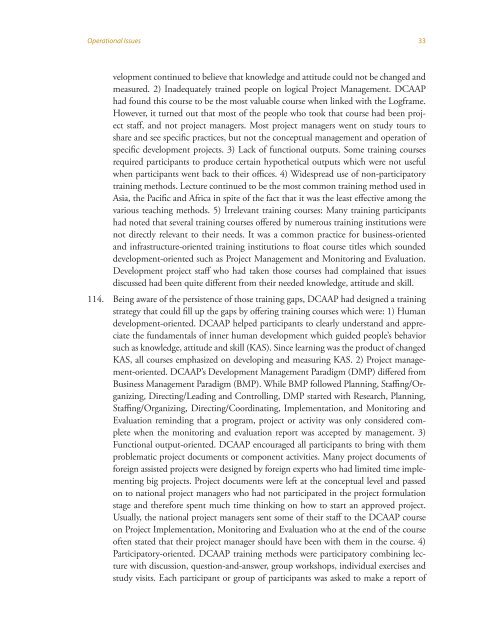16th Meeting of Senior Fellowships Officers of the ... - Development
16th Meeting of Senior Fellowships Officers of the ... - Development
16th Meeting of Senior Fellowships Officers of the ... - Development
Create successful ePaper yourself
Turn your PDF publications into a flip-book with our unique Google optimized e-Paper software.
Operational Issues 33<br />
velopment continued to believe that knowledge and attitude could not be changed and<br />
measured. 2) Inadequately trained people on logical Project Management. DCAAP<br />
had found this course to be <strong>the</strong> most valuable course when linked with <strong>the</strong> Logframe.<br />
However, it turned out that most <strong>of</strong> <strong>the</strong> people who took that course had been project<br />
staff, and not project managers. Most project managers went on study tours to<br />
share and see specific practices, but not <strong>the</strong> conceptual management and operation <strong>of</strong><br />
specific development projects. 3) Lack <strong>of</strong> functional outputs. Some training courses<br />
required participants to produce certain hypo<strong>the</strong>tical outputs which were not useful<br />
when participants went back to <strong>the</strong>ir <strong>of</strong>fices. 4) Widespread use <strong>of</strong> non-participatory<br />
training methods. Lecture continued to be <strong>the</strong> most common training method used in<br />
Asia, <strong>the</strong> Pacific and Africa in spite <strong>of</strong> <strong>the</strong> fact that it was <strong>the</strong> least effective among <strong>the</strong><br />
various teaching methods. 5) Irrelevant training courses: Many training participants<br />
had noted that several training courses <strong>of</strong>fered by numerous training institutions were<br />
not directly relevant to <strong>the</strong>ir needs. It was a common practice for business-oriented<br />
and infrastructure-oriented training institutions to float course titles which sounded<br />
development-oriented such as Project Management and Monitoring and Evaluation.<br />
<strong>Development</strong> project staff who had taken those courses had complained that issues<br />
discussed had been quite different from <strong>the</strong>ir needed knowledge, attitude and skill.<br />
114. Being aware <strong>of</strong> <strong>the</strong> persistence <strong>of</strong> those training gaps, DCAAP had designed a training<br />
strategy that could fill up <strong>the</strong> gaps by <strong>of</strong>fering training courses which were: 1) Human<br />
development-oriented. DCAAP helped participants to clearly understand and appreciate<br />
<strong>the</strong> fundamentals <strong>of</strong> inner human development which guided people’s behavior<br />
such as knowledge, attitude and skill (KAS). Since learning was <strong>the</strong> product <strong>of</strong> changed<br />
KAS, all courses emphasized on developing and measuring KAS. 2) Project management-oriented.<br />
DCAAP’s <strong>Development</strong> Management Paradigm (DMP) differed from<br />
Business Management Paradigm (BMP). While BMP followed Planning, Staffing/Organizing,<br />
Directing/Leading and Controlling, DMP started with Research, Planning,<br />
Staffing/Organizing, Directing/Coordinating, Implementation, and Monitoring and<br />
Evaluation reminding that a program, project or activity was only considered complete<br />
when <strong>the</strong> monitoring and evaluation report was accepted by management. 3)<br />
Functional output-oriented. DCAAP encouraged all participants to bring with <strong>the</strong>m<br />
problematic project documents or component activities. Many project documents <strong>of</strong><br />
foreign assisted projects were designed by foreign experts who had limited time implementing<br />
big projects. Project documents were left at <strong>the</strong> conceptual level and passed<br />
on to national project managers who had not participated in <strong>the</strong> project formulation<br />
stage and <strong>the</strong>refore spent much time thinking on how to start an approved project.<br />
Usually, <strong>the</strong> national project managers sent some <strong>of</strong> <strong>the</strong>ir staff to <strong>the</strong> DCAAP course<br />
on Project Implementation, Monitoring and Evaluation who at <strong>the</strong> end <strong>of</strong> <strong>the</strong> course<br />
<strong>of</strong>ten stated that <strong>the</strong>ir project manager should have been with <strong>the</strong>m in <strong>the</strong> course. 4)<br />
Participatory-oriented. DCAAP training methods were participatory combining lecture<br />
with discussion, question-and-answer, group workshops, individual exercises and<br />
study visits. Each participant or group <strong>of</strong> participants was asked to make a report <strong>of</strong>

















